What are the crowns on the teeth

An artificial crown serves to restore the shape and functioning of the tooth.
The main task of the crown is to strengthen the tooth and prevent its further destruction.
Crowns are single and as part of a bridge structure.
Before fixing the crown on the tooth, it is prepared accordingly. One of the preparation stages is the preparation of the tooth, i.e. it is turned.
The thickness of hard tissues removed from the tooth surface depends on the type of crown.
When installing a structure made of cermet, the tooth is sharpened more than when fixing metal or ceramic crowns.
The edge of the crown is immersed under the gum by 0.3 - 0.5 mm.
Modern dentistry offers patients reliable and highly aesthetic designs.
What are the crowns on the teeth and what to choose? This question is often asked by patients to their dentist.
Types of Dental Crowns
The types of crowns on teeth differ among themselves in that they can be made of various materials.
Most often, structures are made from alloys of metals and ceramics, or by a combination thereof.
Cermet
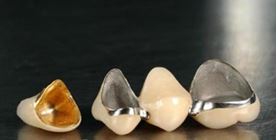
The inner layer of such a crown is a frame made of metal or alloys, the thickness of which is 0.3 - 0.5 mm.
Outside, the metal frame is lined with ceramics.
In the manufacture of the frame structure, both cheap metal alloys and precious metals (platinum, gold, palladium) can be used.
Among the advantages of cermets can be distinguished:
- Good aesthetics.
- Durability and reliability.
- Affordable cost.
The disadvantages include:
- The need for nerve removal (depulpation).
- Sanding on each side of the tooth 1.5 - 2 mm hard tissue.
Video: “Ceramic-metal crowns”
Ceramic
Unlike metal-ceramic constructions, these crowns do not have a metal frame and are made entirely of ceramics.
Due to the absence of metal, ceramic crowns cannot be distinguished from real teeth, i.e. They have excellent aesthetics.
Most often, ceramic structures are made of zirconia and porcelain. Very rarely alumina is used.
Porcelain crowns
According to its physical and optical properties, porcelain has a high resemblance to tooth enamel, therefore it is able to perfectly reproduce the color and translucency of real teeth.
The advantage of porcelain crowns is excellent aesthetics and its stability.
Among the shortcomings of structures made of porcelain is the impossibility of manufacturing a bridge and a very high cost.
Only single crowns for teeth are made of porcelain.
Zirconia Structures
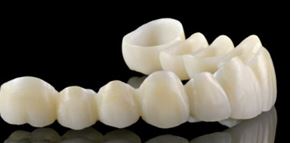
Zirconium is a popular modern material for the production of dental crowns.
The design is made on a frame of zirconia, on top of which porcelain is applied.
Unlike a metal frame, zirconium has excellent light transmittance.
- The advantages of zirconium dioxide are reliability, accuracy of fit, the highest aesthetics, strength, and long service life.
- The disadvantage of zirconium structures is the very high price.
Metal crowns
Varieties of all-metal structures are cast and stamped crowns.
Solid cast crowns - crowns that are cast from metal according to the exact model of teeth.
The advantages of cast crowns are high strength, excellent wear resistance, long service life, low cost.
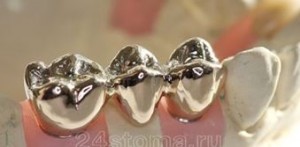
Stamped constructions are an obsolete variety of crowns, which were made from billets - steel sleeves, with further gold plating.
The only advantage of stamped crowns is minimal tooth turning and low price.
Design disadvantages:
- Lack of aesthetics.
- Fast wear associated with the presence of thin walls of the prosthesis.
- Poor workmanship: the design does not tightly cover the neck of the tooth, as a result, saliva, microorganisms, food debris can fall under the crown. Subsequently, the tooth under the crown begins to rot.
Gold crowns
At present, gold crowns are mainly made only in state clinics, since dentistry must have a license to work with precious metals, which is difficult to obtain.
Metal composite crowns
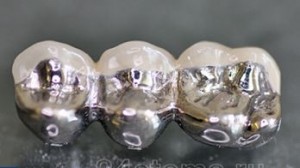
These are combined constructions, which are made by casting, followed by facing the front surface of the tooth with plastic.
For this reason, they are also called metal-plastic.
Advantages - a good aesthetics.
Disadvantages:
- The rapid loss of plastic aesthetic appearance. Over time, the plastic takes on a gray tint.
- One of the properties of plastic is the absorption of various liquids, which leads to its swelling. The result is bad breath.
- Insecurity of plastics. With increased chewing, plastic lining may fall out.
- Plastic crowns emit substances that are harmful to health and are contraindicated for people with a tendency to allergic reactions.
Plastic crowns are used for temporary use.
Affordable price, lightness of material, short production time make the plastic crown ideal for fixation on implants for the time of their engraftment and on prepared teeth during the manufacture of a permanent dental structure.
Implant-supported crowns
Ideal for prosthetics on implants of the anterior tooth group - non-metal ceramic structures.
To achieve the best aesthetics, it is advisable to install a ceramic abutment.
For teeth of the chewing group, functionality is of greater importance, and aesthetics are secondary, therefore, for prosthetics of these teeth, metal-ceramic crowns can be preferred.
Cost
The price of a dental crown is directly related to factors such as the type of material, design methodology, status and location of the dental clinic, and the qualifications of the dentist and dental technician.
| Type of tooth crown | Construction price in rubles |
| Porcelain crown | 13000 |
| Zirconium oxide construction | 16000 |
| Ceramic-metal crown | 6000 |
| Temporary plastic construction | 800 — 1000 |
| Solid metal crown | 3000 |
| Metal-plastic construction | 4000 |
| Cermet crown for implant | 10000 — 14000 |
| Zirconium construction including abutment | 25000 |
Which crowns are better
The choice of material of crowns should be carried out according to indications and together with the doctor.
A dentist who is interested in performing high-quality prosthetics will always explain to the patient about the advantages and disadvantages of one or another type of dental crown suitable for a particular patient.
- Thus, the best crowns will be those that the doctor recommends.
- If we are talking about the advantages and disadvantages of materials for the manufacture of structures, then the fact that the leading position is occupied by crowns made of non-metal ceramics is indisputable.
- They are quite durable, wear-resistant and ideal in terms of aesthetics.
- When choosing a clinic and a dentist, you need to understand that high-quality designs cannot be cheap and can be made in one day.
- Poorly made construction can cause complications and unpleasant problems. If after prosthetics the patient feels discomfort, then this is an occasion to immediately visit a doctor.
Before and after photos
 |
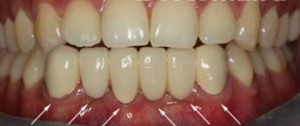 |
 |
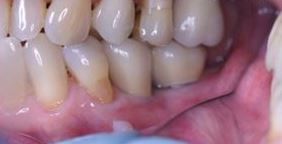 |
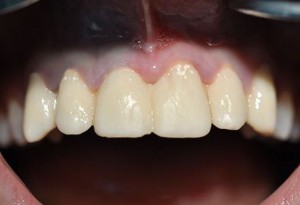 |
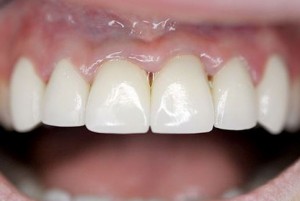 |